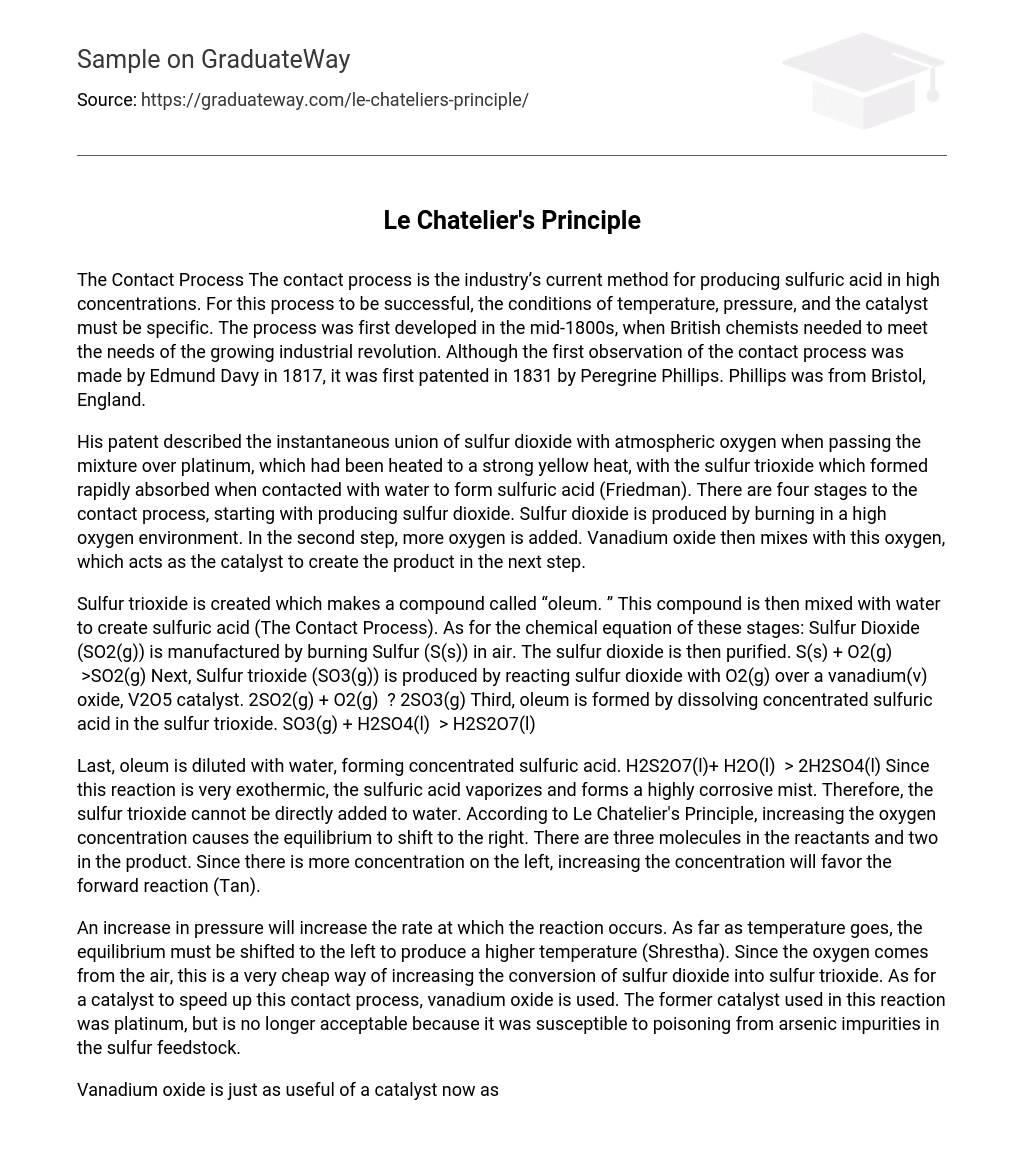The Contact Process The contact process is the industry’s current method for producing sulfuric acid in high concentrations. For this process to be successful, the conditions of temperature, pressure, and the catalyst must be specific. The process was first developed in the mid-1800s, when British chemists needed to meet the needs of the growing industrial revolution. Although the first observation of the contact process was made by Edmund Davy in 1817, it was first patented in 1831 by Peregrine Phillips. Phillips was from Bristol, England.
His patent described the instantaneous union of sulfur dioxide with atmospheric oxygen when passing the mixture over platinum, which had been heated to a strong yellow heat, with the sulfur trioxide which formed rapidly absorbed when contacted with water to form sulfuric acid (Friedman). There are four stages to the contact process, starting with producing sulfur dioxide. Sulfur dioxide is produced by burning in a high oxygen environment. In the second step, more oxygen is added. Vanadium oxide then mixes with this oxygen, which acts as the catalyst to create the product in the next step.
Sulfur trioxide is created which makes a compound called “oleum. ” This compound is then mixed with water to create sulfuric acid (The Contact Process). As for the chemical equation of these stages: Sulfur Dioxide (SO2(g)) is manufactured by burning Sulfur (S(s)) in air. The sulfur dioxide is then purified. S(s) + O2(g) >SO2(g) Next, Sulfur trioxide (SO3(g)) is produced by reacting sulfur dioxide with O2(g) over a vanadium(v) oxide, V2O5 catalyst. 2SO2(g) + O2(g) ? 2SO3(g) Third, oleum is formed by dissolving concentrated sulfuric acid in the sulfur trioxide. SO3(g) + H2SO4(l) > H2S2O7(l)
Last, oleum is diluted with water, forming concentrated sulfuric acid. H2S2O7(l)+ H2O(l) > 2H2SO4(l) Since this reaction is very exothermic, the sulfuric acid vaporizes and forms a highly corrosive mist. Therefore, the sulfur trioxide cannot be directly added to water. According to Le Chatelier’s Principle, increasing the oxygen concentration causes the equilibrium to shift to the right. There are three molecules in the reactants and two in the product. Since there is more concentration on the left, increasing the concentration will favor the forward reaction (Tan).
An increase in pressure will increase the rate at which the reaction occurs. As far as temperature goes, the equilibrium must be shifted to the left to produce a higher temperature (Shrestha). Since the oxygen comes from the air, this is a very cheap way of increasing the conversion of sulfur dioxide into sulfur trioxide. As for a catalyst to speed up this contact process, vanadium oxide is used. The former catalyst used in this reaction was platinum, but is no longer acceptable because it was susceptible to poisoning from arsenic impurities in the sulfur feedstock.
Vanadium oxide is just as useful of a catalyst now as platinum was then (Chemistry Tutorial). Bibliography Chemistry Tutorial: Sulfuric Acid Production. (n. d. ). Retrieved May 2, 2013, from AUS-e-TUTE website: http://www. ausetute. com. au/sulfacid. html Friedman, L. J. , & Friedman, S. J. (n. d. ). The History of the Contact Sulfuric Acid Process. Retrieved May 2, 2013, from Acid Engineering & Consulting, Inc. website: http://www. aiche-cf. org/Clearwater/2008/Paper2/8. 2. 7. pdf Shrestha, B. (n. . ). Manufacture of sulfuric acid by contact process, properties of use. Retrieved from Chem-Guide website: http://chem-guide. blogspot. com/2010/04/laboratory-preparation-preparation-and. html Tan, J. (2008, September 24). Le Chatelier’s Principle. Retrieved May 2, 2013, from http://chmystery. blogspot. com/2008/09/contact-process. html The Contact Process. (n. d. ). Retrieved May 2, 2013, from Xtreme Papers website: http://www. xtremepapers. com/revision/a-level/chemistry/physical/equilibria/contact. php





